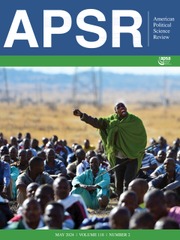Article contents
Reevaluating the Middle-Class Protest Paradigm: A Case-Control Study of Democratic Protest Coalitions in Russia
Published online by Cambridge University Press: 11 September 2017
Abstract
A large literature expects rising middle classes to promote democracy. However, few studies provide direct evidence on this group in nondemocratic settings. This article focuses on politically important differentiation within the middle classes, arguing that middle-class growth in state-dependent sectors weakens potential coalitions in support of democratization. I test this argument using surveys conducted at mass demonstrations in Russia and detailed population data. I also present a new approach to studying protest based on case-control methods from epidemiology. The results reveal that state-sector professionals were significantly less likely to mobilize against electoral fraud, even after controlling for ideology. If this group had participated at the same rate as middle-class professionals from the private sector, I estimate that another 90,000 protesters would have taken to the streets. I trace these patterns of participation to the interaction of individual resources and selective incentives. These findings have implications for authoritarian stability and democratic transitions.
- Type
- Research Article
- Information
- Copyright
- Copyright © American Political Science Association 2017
Footnotes
I wish to thank Mark Beissinger, Chris Achen, Ben Ansell, Graeme Blair, Ray Duch, Grigo Pop-Eleches, Scott Gehlbach, Kosuke Imai, Tomila Lankina, Kevin Mazur, Tom Remington, Luis Schiumerini, Henry Thompson, Mark Urnov, the Journal’s editor, and four anonymous reviewers for helpful feedback at various stages of this project, and my son Ezra who arrived as I was working on revisions and slept quietly as I finished them. Previous versions of this article were presented at the University of Southern California, Nuffield College, Princeton University, the 2014 Annual Meeting of the American Political Science Association, and the 2015 Annual Meeting of the Midwest Political Science Association. I am grateful to the Levada Center and the Foundation for Public Opinion (FOM) for generously sharing their data.
References
REFERENCES
- 68
- Cited by



Comments
No Comments have been published for this article.